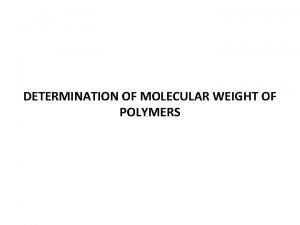OVERVIEW OF METHODS AND TOOLS USED TO DETERMINE

- Slides: 1

OVERVIEW OF METHODS AND TOOLS USED TO DETERMINE THE QUALITY OF WHEAT STORED UNDER VARIOUS CONDITIONS MARIANA VALENTINA PETRE, MONA ELENA POPA University of Agronomic Sciences and Veterinary Medicine of Bucharest, 59 Mărăști Blvd. , District 1, Bucharest, Romania INTRODUCTION Wheat is part of the basic diet of most people, but also of animals around the world. Wheat is grown in a large number of countries, but also in areas with a very different climate. The preservation of cereals that are of superior quality today is a real concern around the globe. Research is currently being carried out to improve but also to panning new methods to overcome the shortcomings in current methods and equipment for determining grain quality. In recent years, many different analytical processes have been used to determine the quality parameters of wheat. MATERIAL AND METHODS Determination of wheat humidity using DBS 60 -3, Kern, Balingen, Germany and other equipment. Infrared spectroscopy Fourier is a quick and accurate method of identifying insects. Electronic nose is a technique for rapid and accurate deterioration detection of grains. The hectolitre mass is determined using a two-level funnel according to the (AACC) method 55 -10, 2000. The rheological properties are assessed with the Chopin NG alveograph, mixograph, pharinograph, mixolab and Brabender Amilograph. Detection of foreign bodies in cereals is difficult using conventional measurement methods. The field of reflection imaging of terahertz time spectroscopy is proposed as a nondestructive and highly penetrating technique for detecting foreign bodies found in wheat samples. Imaging systems for assessing grain quality, visualisation systems are non-destructive, non-contact and non-invasive methods of assessing the quality of food grain. The approach can provide rapid and accurate information on external quality aspects of cereals. Falling Number is based on viscosity, is used to make an immediate assessment of the activity of α-amylase of wheat flour. Method for determining aflatoxin contamination in wheat using the Vicam. Afla HPLC column. Omeg Analyzer G, Bruins instruments has been used for the photometric determination of starch and protein content. A Foss NIR system model 6500, which measures wavelength refraction 400 -2498 nm, is usually used to check wheat quality. This device was used to determine the protein content of the grain. The determination method of wet gluten using the Perten glutomatic system and Glutopeak equipment. CONCLUSIONS • This overview presents some of the methods and equipment used in determining the quality of wheat. • There has been an improvement over time in some methods and the patenting of other new procedures to make it easier to work. • The manner we want to work is faster, and the results to be as accurate and precise as possible, all this has generated the implementation of new systems and the improvement of old ones. • The quality of the products offered by the producers is essential for the consumers, therefore in the field of wheat quality we want to monitor the particularities of the cereals, because they pass on the quality of the resulting products. • Modern methods and equipment for determining wheat quality are much faster, more accurate, and easier to perform, but are much more expensive. REFERENCES 1. Mishra, G. , Srivastava, S. , Panda, B. K. , & Mishra, H. N. (2018 c). Sensor array optimization and determination of Rhyzopertha dominica infes‐ tation in wheat using hybrid neuro‐fuzzy‐assisted electronic nose analysis. Analytical Methods, 10(47), 5687– 5695; 2. Anonymous, 2014. Proposed Draft of the Code of Practice for the Prevention and Reduction of Mycotoxin Contamination in Cereals, Including Annexes on Ochratoxin a, Zearalenone, Fumonisins, Trichothecenes and Aflatoxins. Codex Alimentarius Commission, FAO, Rome, Italy, p. 16. CAC/RCP 51 e 2003; 3. Chenling Qu, Hongliang Wang, Shengqiang Liu, Fangting Wang, Chang Liu. Effects of microwave heating of wheat on its functional properties and accelerated storage, 2017;

